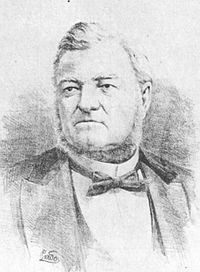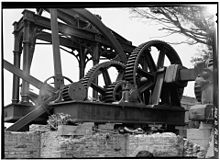| Revision as of 04:08, 5 November 2013 editParkwells (talk | contribs)Autopatrolled, Extended confirmed users, Rollbackers178,650 edits →Marqués de La Esperanza: % of valley controlled← Previous edit | Revision as of 04:11, 5 November 2013 edit undoParkwells (talk | contribs)Autopatrolled, Extended confirmed users, Rollbackers178,650 edits →Early years: EstatesNext edit → | ||
| Line 22: | Line 22: | ||
| ==Early years== | ==Early years== | ||
| Fernández (birth name: José Ramon Fernández y Martínez) was one of three siblings born to Fernando Fernández and Francisca Martínez in ]. Fernández's father was a naval captain who fought against ] and ] merchant ships. In 1797, the Spanish Royal Crown granted him land in the towns of ] and Manati in recognition of his service to ]. In Bayamon he planted ] and raised cattle.<ref></ref> His father named the property the "Santa Ana Plantation". In 1804, the elder Fernández used a mixture of sugar and honey to process and distill rum. He aged his product in special barrels which were imported from ]. The rum he produced was only for his own personal use and that of his family. | Fernández (birth name: José Ramon Fernández y Martínez) was one of three siblings born to ] and Francisca Martínez in ]. Fernández's father was a naval captain from Castile who fought against ] and ] merchant ships. In 1797, the Spanish Royal Crown granted him land in the towns of ] and Manati in recognition of his service to ]. In Bayamon he planted ] and raised cattle.<ref></ref> His father named the property the "Santa Ana Plantation". In 1804, the elder Fernández used a mixture of sugar and honey to process and distill rum. He aged his product in special barrels which were imported from ]. The rum he produced was only for his own personal use and that of his family. | ||
| In 1827, he ordered his 127 slaves to build an enormous ] shaped like a ]. The windmill helped to extract the juice from the sugar canes. He still resorted to the use of ], whenever the wind wasn't strong enough for to operate the windmill.<ref name="SJH"></ref> The elder Fernández did the same with his other plantation in Manati, which he named |
In 1827, he ordered his 127 slaves to build an enormous ] shaped like a ]. The windmill helped to extract the juice from the sugar canes. He still resorted to the use of ], whenever the wind wasn't strong enough for to operate the windmill.<ref name="SJH"></ref>{{dead link}} The elder Fernández did the same with his other plantation in Manati, which he named ''Hacienda La Esperanza''.<ref name="HLE"/><ref name="JRF">, National Historic Landmark of Mechanical Engineering, American Society of Mechanical Engineers</ref> | ||
| José Fernández received his primary education in Puerto Rico. In 1819 when he was eleven years old, his father sent him to ] to study business |
José Fernández received his primary education in Puerto Rico. In 1819 when he was eleven years old, his father sent him to ] to study business. When he was seventeen, he continued his education in ] where he became fluent in the ]. He went to the ] in his early twenties and continued his education in ]. There he befriended various businessmen who in the future would help him in his commercial endeavors.<ref name="HLE"/><ref name="JRF"/> | ||
| ==Return to Puerto Rico== | ==Return to Puerto Rico== | ||
Revision as of 04:11, 5 November 2013
| José Ramon Fernández | |
|---|---|
 José Ramon Fernández José Ramon Fernández"Marqués de La Esperanza" | |
| Born | 1808 San Juan, Puerto Rico |
| Died | 1883 Manati, Puerto Rico |
| Nationality | Puerto Rican |
| Occupation | Sugar baron |
| Notes | |
| The Spanish Crown bestowed upon him the title of "Marqués de La Esperanza" | |
José Ramon Fernández "Marqués de La Esperanza" (1808–1883), was the wealthiest sugar baron in Puerto Rico in the 19th century. He was also one of the most powerful men of the entire Spanish Caribbean. His wealth and political connections gave him the power to convince the Spanish Colonial government in the island to split the municipality of Manati in two, and thus found the municipality of Barceloneta.
Early years
Fernández (birth name: José Ramon Fernández y Martínez) was one of three siblings born to Fernando Fernández and Francisca Martínez in San Juan, Puerto Rico. Fernández's father was a naval captain from Castile who fought against pirates and English merchant ships. In 1797, the Spanish Royal Crown granted him land in the towns of Bayamon and Manati in recognition of his service to Spain. In Bayamon he planted sugar cane and raised cattle. His father named the property the "Santa Ana Plantation". In 1804, the elder Fernández used a mixture of sugar and honey to process and distill rum. He aged his product in special barrels which were imported from Europe. The rum he produced was only for his own personal use and that of his family.
In 1827, he ordered his 127 slaves to build an enormous windmill shaped like a tower. The windmill helped to extract the juice from the sugar canes. He still resorted to the use of manpower, whenever the wind wasn't strong enough for to operate the windmill. The elder Fernández did the same with his other plantation in Manati, which he named Hacienda La Esperanza.
José Fernández received his primary education in Puerto Rico. In 1819 when he was eleven years old, his father sent him to Spain to study business. When he was seventeen, he continued his education in England where he became fluent in the English language. He went to the United States in his early twenties and continued his education in New York City. There he befriended various businessmen who in the future would help him in his commercial endeavors.
Return to Puerto Rico
Fernández returned to Puerto Rico in 1826 and helped his father to administer La Esperanza sugar plantation. He met and befriended George C. Lattimer, the United States consul in San Juan. Together with Lattimer, who was also a sugar broker, he founded Lattimer & Fernández Co. The company, which was located in San Juan, was a distributor of sugar, molasses and rum, and also dealt with other commodities such as food and textiles.
Fernández married Clemencia Dorado y Serrano. They had four daughters, the youngest of whom died young.
In 1834, he decided to dedicate himself to his commercial interests instead of the agricultural ones. He established a warehouse in the town of Mayaguez where he moved with his family.
Political life
Fernández became president of the "Partido Incondicional Español" (Unconditional Spanish Party), a conservative political party in Puerto Rico. He was appointed to several political positions. He was in good political standing with Queen Isabella II of Spain and the Spanish-appointed government of the island because of his political views; he favored the monarchy and the Spanish colonial government. He became involved with various businesses and in 1850, used his political influence to lobby for the establishment of a railroad line between San Juan and Arecibo, with the financial backing of Augusto de Cottes and Cornelio Kortwright.
Marqués de La Esperanza

An uprising against the monarchs of Spain forced Queen Isabella II to go into exile on September 1868. This revolt, which deposed the queen, is known as the Glorious Revolution. It ushered the First Spanish Republic into power. After much deliberation, the new government replaced Isabella with Amadeo I, son of the Italian king.
The new provisional government allowed its colonies to send representatives to the Spanish Court. Fernández was among those who represented Puerto Rico. On February 5, 1869, the Spanish government bestowed the title of "Marqués de La Esperanza" (Marquis of Hope) upon Fernández.
When his father died, he inherited La Esperanza, which at the time was one of the largest and the most technically advanced sugar plantations in Puerto Rico. "La Esperanza" was situated on 2,265 acres of land rich in alluvial deposits, an important element for the cultivation of sugar cane. By 1880, he controlled 80 percent of the valley. Fernández built the wealth of his plantation on the labor of ethnic African slaves who provided the manpower to cultivate and harvest the sugar cane on the plantation and to run the factory and mill. By the time of emancipation in 1873, Fernández owned 175 slaves.
He also depended on his factory equipment: including a steam engine with two-flue boiler purchased from the West Point Foundry of New York. Designated in 1979 as a National Historic Mechanical Engineering Landmark, the steam engine is the
"only West Point Foundry beam engine known to survive. It is also the only known 6-column beam engine by any American manufacturer. Additionally, it is one of only eight beam engines of American manufacture known to exist anywhere."
The system includes an elaboration (Jamaican) train, conveyor belt, and four evaporators for processing.
Fernández convinced the government to divide the municipality of Manati in two and found the new municipality of Barceloneta. This was clearly for his own economic benefit and not for the political benefits of the residents of either jurisdiction. If he used the port of Manati, Fernández would have to pay taxes for the movement of goods and slaves. In Barceloneta, he built his own port and was able to ship his commodities and products free of taxes.
Legacy
Fernández incurred many debts because of the money which he borrowed to mechanize his plantation. He was unable to pay his debts. When he died, his family became involved in a feud as to who was the rightful inheritor of the plantation. As two of the daughters had married foreigners, the third said she was the only rightful heir. As Fernandez' major creditor, the Colonial Company Ltd. claimed ownership of the land.
In 1975, the Puerto Rico Conservation Trust acquired the Hacienda La Esperanza. La Esperanza is one of the most valuable assets of the Trust. The land includes varied terrain of karst, wetlands, forest, including some of the only coastal forest on the north coast, and river valley. In 1984 the conservation trust began work on the restoration of the plantation structures.
See also
References
- ^ José R. Fernández y Martínez "Marqués de La Esperanza"
- Traveler
- Puerto Rico Herald
- ^ HACIENDA LA ESPERANZA: Steam Engine, National Historic Landmark of Mechanical Engineering, American Society of Mechanical Engineers
- "HABS". Library of Congress. Retrieved 1 December 2011.
- "Queen Isabella II", Womens History
- Hacienda La Esperanza